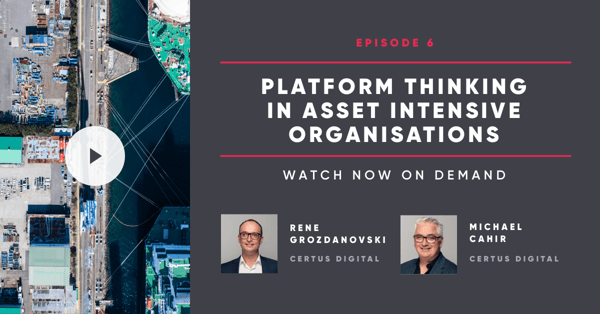Ever since we started #DigitalDialogues, I’ve been looking forward to one particular episode: Platform Thinking. It seems to be one of those concepts that’s simple in theory but still tends to be misunderstood regularly. Therefore, I was looking forward to having the opportunity to talk to two experts on platform thinking and try to clarify and demystify the concept.
Michael Cahir, General Manager at Certus and Samuel Williams, Chief Marketing Officer at Certus are two platform thinking thought-leaders. Since both also have extensive experience in asset intensive industries, they were the ideal guests for this episode.
Michael and Sam did a great job explaining what platform thinking is, why it is more than just a technology stack, the role that ecosystems play and how platform thinking adds value to asset intensive operations. Watch the whole episode on-demand here.
One part that I thought was particularly interesting is how Sam summarised the value a platform approach delivers to asset intensive organisations.
Let’s take a look at the individual elements on Sam’s diagram.
1. Business Problem
Platform thinking starts with a business problem. Organisational leaders need to clarify what problem(s) they want to address; whether that is business enablement, incremental improvement, optimisation of people and processes, better business intelligence or effective innovation.
Only organisations who are clear about what they are aiming for, will be able to apply platform thinking in a way that will help achieve these goals, so this is an essential first step.
2. Delivery
Once the problem is defined, the next part to consider is how to deliver a solution. At Certus, we recommend a DX delivery framework that consists of four phases.
Around this framework, sits an ecosystem of highly experienced partners who can support the delivery of different DX elements, including transformation services, point solutions, systems of record/engagement/information, solutioning services, industry adaption and infrastructure.
The combination of this framework and ecosystem gives asset intensive organisations the best chance of successfully delivering the solutions needed to solve the problems identified.
3. Outcomes
With the problem identified and a robust delivery framework and ecosystem in place, organisations are likely to achieve the desired DX outcomes. For most organisations, these fall into three categories:
As you can see, platform thinking is about much more than your technology stack. It’s an approach and a way of thinking about solving business problems to achieve better outcomes.
If you want to learn more about platform thinking for asset intensive organisations, watch the full episode of #DigitalDialogues on-demand now.

Stay up-to-date with the latest news and receive notifications right to your inbox when new articles are published by subscribing now.